
The Teloschistaceae are a large family of mostly lichen-forming fungi belonging to the class Lecanoromycetes in the division Ascomycota. Many members of the Teloschistaceae are readily identifiable by their vibrant orange to yellow hue, a result of their frequent anthraquinone content. The presence of these anthraquinone pigments, which confer protection from ultraviolet light, enabled this group to expand from shaded forest habitats to harsher environmental conditions of sunny and arid ecosystems during the Late Cretaceous. Collectively, the family has a cosmopolitan distribution, although members occur predominantly in subtropical and temperate regions. Although most members are lichens that either live on rock or on bark, about 40 species are lichenicolous fungi–meaning they live on other lichens.
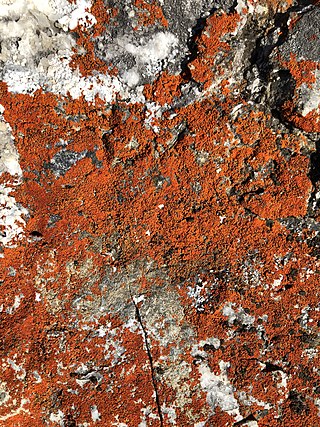
Igneoplaca is a genus in the subfamily Xanthorioideae of the family Teloschistaceae. It contains a single species, the crustose lichen Igneoplaca ignea.

Squamulea is a genus of lichen-forming fungi in the family Teloschistaceae. It has 15 species. The genus was circumscribed in 2013 by Ulf Arup, Ulrik Søchting, and Patrik Frödén, with Squamulea subsoluta assigned as the type species. Five species were included in the original account of the genus. The genus name alludes to the squamulose growth form of most of its species. Squamulea has a worldwide distribution; when the genus was originally created, the centre of distribution was thought to be in southwestern North America.
Sirenophila is a genus of crustose lichens in the subfamily Teloschistoideae of the family Teloschistaceae. It has four species with an Australasian distribution.
Huneckia is a genus of crustose lichens in the subfamily Caloplacoideae of the family Teloschistaceae. It has four species.
Amundsenia austrocontinentalis is a species of saxicolous (rock-dwelling), crustose lichen in the family Teloschistaceae, and the type species of genus Amundsenia. Found in Antarctica, it was formally described as a new species in 2014 by Isaac Garrido-Benavent, Ulrik Søchting, Sergio Pérez-Ortega, and Rod Seppelt. The type specimen was collected by the last author from Mule Peninsula, where it was found growing on small stones in glacial till. The species epithet austrocontinentalis refers to its distribution in continental Antarctica.

Wetmoreana is a genus of lichen-forming fungi in the family Teloschistaceae. It has two crustose, saxicolous (rock-dwelling) species.
Catenarina is a genus of lichen-forming fungi in the family Teloschistaceae consisting of three species. These crustose lichens are characterized by their reddish-brown pigmentation and the presence of the secondary compound 7-chlorocatenarin. The genus is found in the southernmost regions of the Southern Hemisphere, including Antarctica, southern Patagonia, and the Kerguelen Islands.
Catenarina desolata is a species of lichen in the family Teloschistaceae. It was formally described as a new species in 2014 by lichenologists Ulrik Søchting, Majbrit Søgaard, and Arve Elvebakk. It is predominantly found in the southernmost parts of Chile, with some instances in Antarctica and the Kerguelen Islands. Characterised by its dark reddish-brown to almost purple apothecia, this species of lichen was originally thought to be lichenicolous, meaning it grows on other lichens, particularly Aspicilia species. The later discovery non-lichen-dwelling examples from James Ross Island in the Antarctic Peninsula suggests that it is not exclusively lichenicolous. Its distinctive secondary compound, 7-chlorocatenarin, sets it apart from other lichens in the region.
Catenarina vivasiana is a species of crustose lichen in the family Teloschistaceae. It is found in the southernmost regions of South America, predominantly in Chile. Characterised by its dark reddish-brown thallus and unique chemistry, this lichen is named in honour of Spanish lichenologist Mercedes Vivas. It was formally described as a new species in 2014.
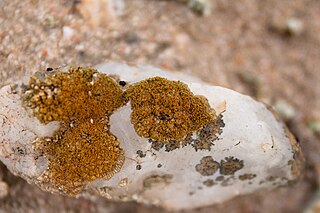
Stellarangia is a genus of lichen-forming fungi in the family Teloschistaceae. It has three species of saxicolous (rock-dwelling), crustose lichens. Species of Stellarangia are found in dry, desert areas in Namibia and South Africa.
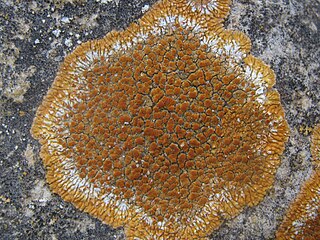
Variospora flavescens is a species of saxicolous (rock-dwelling), crustose lichen in the family Teloschistaceae. It is a common, widely distributed species and has been recorded in Africa, Asia, Europe, and Macaronesia.
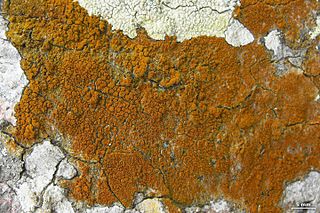
Lacrima is a genus of lichen-forming fungi in the family Teloschistaceae. It has four saxicolous (rock-dwelling), crustose species.
Austroplaca hookeri is a species of saxicolous (rock-dwelling), crustose lichen in the family Teloschistaceae. It was originally described by Carroll William Dodge in 1965, as Gasparrinia hookeri. The type specimen was originally collected by British botanist and explorer Joseph Dalton Hooker on Cockburn Island; the species is named in his honour. The taxon was transferred to the large genus Caloplaca in 2004, and again to the genus Austroplaca in 2013 as part of a restructuring of the family Teloschistaceae.
Caloplaca nigra is a species of saxicolous (rock-dwelling), crustose lichen in the family Teloschistaceae. Found on rocks predominantly in the Galápagos Islands, it is characterised by its dark reproductive structures.
Haloplaca is a genus of lichen-forming fungi in the subfamily Teloschistaceae of the family Teloschistaceae. It contains three species of crustose lichens. The genus was circumscribed by Ulf Arup and colleagues in 2013, with Haloplaca britannica assigned as the type species. The genus name alludes to the preference of its species for salt-rich environments. All three species occur in the United Kingdom, but H. suaedae also occurs in Greece, Morocco and Turkey. Haloplaca species occur near the sea, either on rocks or on plant debris.
Solitaria is a fungal genus in the family Teloschistaceae. It contains a single species, the corticolous (bark-dwelling), crustose lichen Solitaria chrysophthalma.

Wetmoreana brouardii is a species of saxicolous (rock-dwelling), crustose lichen in the family Teloschistaceae.
Usnochroma is a genus of lichen-forming fungi in the family Teloschistaceae. It has two species of crustose lichens. The genus was circumscribed in 2013 by lichenologists Ulrik Søchting, Ulf Arup, and Patrik Frödén, with Usnochroma carphineum assigned as the type species. The genus name refers to the yellowish-green colour of the thallus, which is caused by the substance usnic acid. Usnochroma species occur in Macaronesia, South Africa, the Mediterranean Basin, and Algeria.
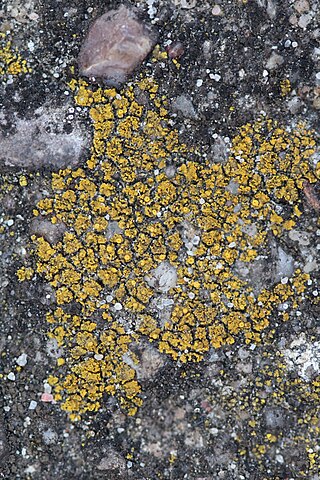
Flavoplaca arcis is a species of saxicolous (rock-dwelling), crustose to squamulose (scaley) lichen in the family Teloschistaceae. Although widely distributed in Northern, Central, and Western Europe, it is not commmonly encountered.








